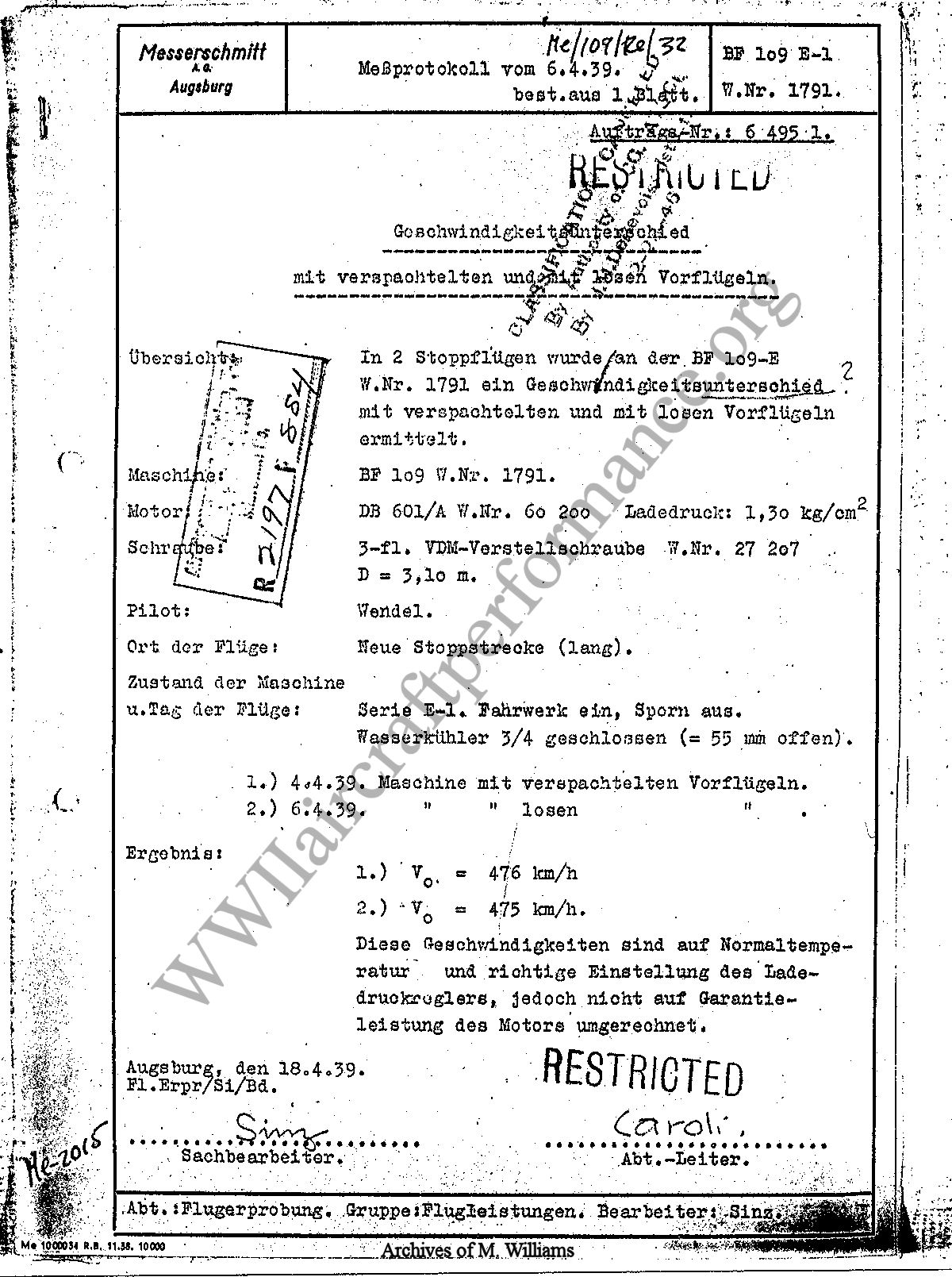
 |
|
#31
|
|||
|
|||
|
Quote:
According to Uwe Feist in "The Fighting Me 109", published London: Arms and Armour Press, 1993, there were two prototypes built to test the 109 with the DB601: V14, which had two MG's in the nose, and two F/F 20mm in the wings and which was equipped with a DB-601Ao engine, and V15, which had only had the two nose MG's, (no weapons mounted in the wings at all) and which it appears, was equipped with the DB-601Aa engine. According to Wiki, V14 was determined to be the more successful of the two prototypes, and there was an initial pre-production order of 20, designated E-0. Later, early production 109E's were sent to Spain to be tested with the Condor Legion. Production later commenced with the E-1 variant, with two MG's in the wings. This information clearly points out the difference between V15 and the later production aircraft. This aircraft did not have the drag or weight of a pair of MG F/F's and their ammunition to contend with. And who knows what else was not present? The question is, where is the test of V14? |
|
#32
|
|||
|
|||
|
Quote:
"It clearly points out"................nothing . Last edited by KG26_Alpha; 10-10-2012 at 04:48 PM. |
|
#33
|
|||
|
|||
|
I don't think it is questionable if aircraft's condition is representative enough for a standard 109E. I'd say it is close enough, there are always differences between individual aircraft, even if all of them are brought up to the same specs. Weight is pretty much irrelevant at high speed, and drag from wing installed weapons was shown to be small. I also think the methods employed are sound, and the data is as solid as test data can be.
So far so good, but for me there are other open questions, mostly regarding high altitude performance. It was brought up in another topic - a plane going 500 at SL should manage a lot more than 575 at 5000m, if it has slightly more power available at altitude. Doesn't make sense the way it is. Also, V15 having a DB601Aa engine, the full throttle altitude of 4900m is unreasonably high, no answer found as of yet. Spitfire tests do not show this kind of problems, which makes it easier for me to accept their results. They are more plausible. OTOH, Spitfire test results usually get less corrections and would therefore be less accurate. |
|
#34
|
||||
|
||||
|
Quote:
Quote:
"An Bf 109 V 15 a, der Mustermachine für die E-1-Serie, wurden die Geschwindigkeitsleistungen erflogen. ... 2 Flügel- und 2 Hauben-MG eingebaut." Quote:
Quote:
__________________
Il-2Bugtracker: Feature #200: Missing 100 octane subtypes of Bf 109E and Bf 110C http://www.il2bugtracker.com/issues/200 Il-2Bugtracker: Bug #415: Spitfire Mk I, Ia, and Mk II: Stability and Control http://www.il2bugtracker.com/issues/415 Kurfürst - Your resource site on Bf 109 performance! http://kurfurst.org 
|
|
#35
|
|||
|
|||
|
Quote:
Another note re. V15: As mentioned, neither the 109E1 or 109E3 were in production when V15 was constructed, so it was impossible for it to be modelled on them, they didn't exist. As anyone who has looked at the history of the 109 knows, the 'V' designation indicates a prototype or test aircraft. |
|
#36
|
|||
|
|||
|
Quote:
Second, if your quote is accurate, then it is clearly not an E-3 which is being tested, it is an E-1, which was lighter, not having the MG F/F 20mm cannon and ammunition, and faster. The sea level speeds of the E-1 and E-3 were noted as clearly being different. E-1: (this is a test a full year later than the V15 test, AND it is of a PRODUCTION 109E-1)  E-3  If you are arguing the 109E-1 should be faster, perhaps to the V15a, (please provide the missing page) then perhaps you have a case, although the above document suggests speed should be higher than the E-3, but considerably less than V15. As far as the E-3 and E-4, many questions remain, nothing has been proved to suggest their speeds should be similar to V15's. Last edited by *Buzzsaw*; 10-10-2012 at 05:34 PM. |
|
#37
|
|||
|
|||
|
Quote:
Quote:
Here's another take on it. If you look at Spitfire I speeds, roughly 285 mph at SL and about 355 mph at FTH, and the Merlin III's output, you will see that the Merlin has a good deal less power at SL than the DB 601A/Aa (about 870 HP vs 1045 PS). At rated altitude, the Merlin offers a bit more power, but the two aircraft reach about the same top speed. In short, the 109E needs less power at altitude, which quite clearly points to less overall drag in the high speed regime. So how on Earth would be it be slower or just as fast than Spitfire with more power (100-150 PS more) near SL...? [/QUOTE] Also, V15 having a DB601Aa engine, the full throttle altitude of 4900m is unreasonably high, no answer found as of yet.[/QUOTE] I don't think it's very unreasonable, 1000-1200 m gain in FTH due to high speed rammed power seems fairly typical, and it's seems it is what in all tests agree. Quote:
__________________
Il-2Bugtracker: Feature #200: Missing 100 octane subtypes of Bf 109E and Bf 110C http://www.il2bugtracker.com/issues/200 Il-2Bugtracker: Bug #415: Spitfire Mk I, Ia, and Mk II: Stability and Control http://www.il2bugtracker.com/issues/415 Kurfürst - Your resource site on Bf 109 performance! http://kurfurst.org 
|
|
#38
|
|||
|
|||
|
Quote:
|
|
#39
|
|||
|
|||
|
Quote:
The fact is, pilots will do things which are not necessarily in the manual, just because they are pilots. Last edited by *Buzzsaw*; 10-10-2012 at 05:53 PM. |
|
#40
|
|||
|
|||
|
Quote:
I'd like to see the document where V15's loadout is mentioned. |
 |
|
|